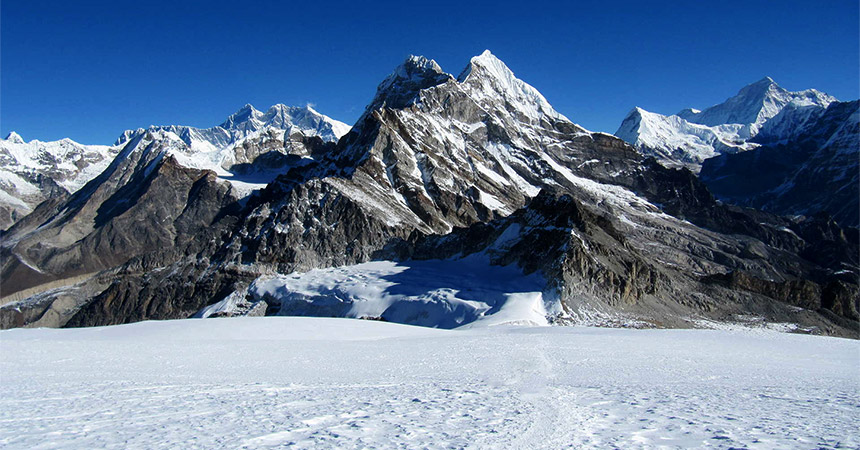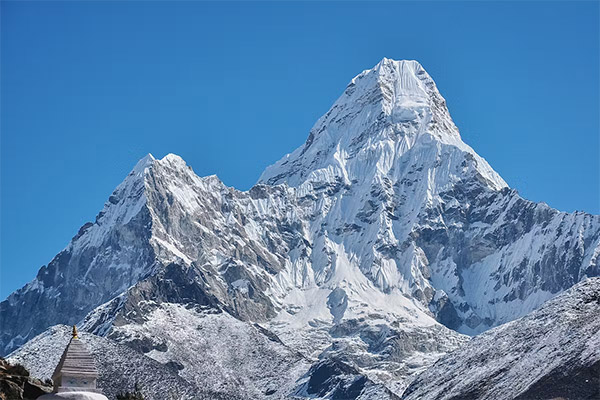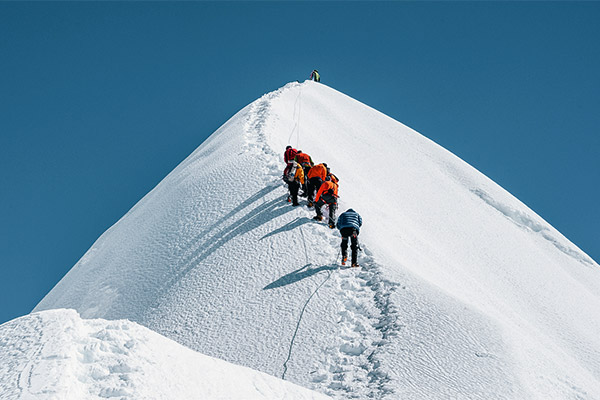- Trekking
- Expedition in Nepal
- Inbound Tours
- Outbound Tours
- About Us
- Contact us

Located in the Khumbu Region, Mera Peak (6,461m) is the highest and popular trekking peak in Nepal. The endeavor of conquering Mera Peak is an exciting adventure that combines trekking across breathtaking scenery with summit experience. Unlike Island Peak Climbing, Mera Peak presents a less demanding ascent. Mera Peak is higher, but the path is easy and requires minimal technical skill. Although the snow route is not particularly steep, the long day will exhaust you. Mera Peak can be climbed by novice climbers, but it requires exceptional physical fitness, endurance, and stamina. Away from the regular Everest Route, the Mera Peak climbing constitutes an extended yet picturesque venture through traditional Sherpa settlements, terraced farmlands, verdant forest, suspension bridges, ancient monasteries, fluttering prayer flags, and numerous other sights.
The commencement of the Mera Peak Climbing experience is marked by a captivating aerial flight from Kathmandu to Lukla. An entry point that sets the stage for exploration within the Khumbu region. The initial stages of the trail lead downward through lush forests, Yak pastures, eventually guiding us through the glacial moraines. Continuing in our destination, the trail traverses a series of Sherpa communities, including Chutang, Thuli Kharka, Kothe, Thangnak, and finally Khare. The moment we leave the breathtaking high-alpine landscape behind, Mera Peak emerges in all its splendor, dominating the skyline.
Reaching the summit of Mera Peak offers an unparalleled vantage point to marvel at the magnificent spectacle. The five of the world’s towering eight-thousanders: the Mount Everest, Mount Kanchenjunga, Mount Makalu, Mount Cho Oyu, and Mount Lhotse. This breathtaking panorama serves as a fitting reward for the rigorous journey, capping off the exhilarating saga of Mera Peak Climbing.
Upon your arrival in Kathmandu, you will be greeted at the airport and transferred to your hotel. Later in the evening, we will have a pre-departure meeting regarding the details of your trip.
In the morning, we will pick you from your hotel and then drive to the airport for our scenic flight to Lukla (2,800m). We embark on our first day of trek heading east from Lukla to Chutang. Initially our trail is dotted with several Sherpa villages, pass Buddhist Mani walls and prayer wheels before entering less trekked trail surrounded by dense Pine and Rhododendron forests.
Our second day of trekking is long and strenuous. Away from Chutang, we will traverse through a vibrant rhododendron forest and meander across stretches of Yak pasture lands. Our journey takes a steep ascent along the Kalo Himal Ridge, marking the initial demanding climb of the Mera Peak expedition. Every ounce of effort will be required to reach the summit of Zatrawala Pass (4,610m), which separates Khumbu from the Hinku Valley. From this vantage point, panoramic vistas unfold, offering picturesque views of prominent peaks such as Kongdi Ri, Karyolang Peak, Number Himal, Lumding Himal, and a host of others. Subsequently, we embark on a descent along a stony pathway, leading us to the destination of Thuli Kharka.
Setting out from Thuli Kharka, our route descends along a rugged trail. This journey entails a series of uphill and downhill sections, guiding us through a lush pine, oak, and rhododendron forest. Amidst this verdant backdrop, spectacular vistas of Mera Peak, Kusum Kanguru, Peak 43, and even a fleeting glimpse of Mount Everest unfold before us. Then the trail winds in zigzags through forested area before descending steeply to the banks of the Hinku River within the Hinku Valley. Continuing our journey, we ascend from the riverbank, eventually arriving at the destination of Kothe.
Following the course of the Hinku River, the trail winds through the riverbed and traverses pasturelands, eventually leading to Gondishung. Continuing onward, we’ll encounter an ancient Buddhist monastery known as Lungsumgba Gompa, steeped in a history that spans two centuries. As the elevation increases, the lush treeline gradually recedes. The path continues to ascend, eventually bringing us to our destination of Thagnak, where you’ll spend the night. Throughout this stretch, the journey is adorned with breathtaking vistas, including awe-inspiring sights of Mera Peak, Charpati Himal, Kusum Kanguru, and Thamserku.
Today we will rest and acclimatize. To remain active, we will undertake a visit to the moraine-dammed lake known as Sabai Tsho.
The trek for today is brief, yet the increasing altitude adds a challenging element. Moving away from Tangnag, the path takes a steep ascent over moraine terrain, leading to the wide pasture called Dig Kharka. Here, we’re rewarded with splendid vistas encompassing the Kyeshar Glacier, Mera Peak, and Charpati Himal. Subsequently, the journey involves a rigorous uphill climb, guiding us along the Hinku Nup and Shar glaciers until we reach Khare, gateway to Mera Peak.
Today is another acclimatization and pre-climb training day. Our skilled Sherpa guides will offer comprehensive training in peak climbing methodologies, including the proper handling of essential climbing gear like ice axes, crampons, harnesses, and other equipment. This instruction will also cover rope techniques for both ascending and descending.
Today’s trek brings us in proximity to Mera Peak, positioning us just one night away from reaching the peak itself. Navigating a steep and rocky path through the glacier, we arrive at Mera La. From this vantage point, we’re treated to breathtaking vistas of Mera Peak’s trio of summits – Mera South (6,065m), Mera North (6,476m), and our target, Mera Central (6,461m). Thepath then involves a challenging ascent to the top of Mera Glacier, leading us to Mera High Camp. This elevated position provides a panoramic spectacle that encompasses the sight of five of the renowned 14 eight-thousanders: Mount Everest (8,848m), Kanchenjunga (8,586m), Lhotse (8,516m), Makalu (8,485m), and Cho Oyu (8,188m). Additionally, the high camp offers captivating vistas of other significant peaks like Chamlang (7,319m), Gaurishanker (7,134m), and Baruntse (7,129m).
Starting early in the morning, our goal is to reach the summit of Mera Peak before noon to avoid strong afternoon winds. Following the footsteps of experienced Sherpa guides, we steadily ascend on snowfields, carefully navigating away from crevasses to reach at the snow-covered summit of Mera Peak.
Standing atop Mera Peak, a mesmerizing panorama unveils itself. With close-up views of prominent peaks including Everest, Makalu, Kanchenjunga, Lhotse, Cho Oyu, Nuptse, Chamlang, Baruntse, Ama Dablam, and Kangtega, you’ll have ample time to soak in the stunning surroundings. After cherishing this memorable experience, we descend to the high camp and then continue to Khare.
Bidding farewell to the mountains we retrace our way back via Thangnak to Kothe. As we get closer to Kothe, the sight of treelines becomes visible again.
Today, we follow the same route back, passing through vibrant forests and yak grazing lands. Along the way, we delight in the sight of Mera Peak and other majestic mountains. Our destination is Thuli Kharka, situated just below Zatrwa La.
Today is our final day of trekking and it will be long and strenuous. We’ll face the challenge of ascending to the summit of Zatrwa La before descending towards Lukla. This path will take us through picturesque yak pastures, verdant forests, and several Sherpa settlements. Throughout the journey, we’ll be treated to splendid views of the surrounding mountains.
Our return to Kathmandu will depend on the weather conditions. If the weather permits, we will board a flight from Lukla back to Kathmandu. Upon arrival in Kathmandu, we will drop you to your respective hotels, where you can settle in and relax after our exhilarating trekking expedition.

